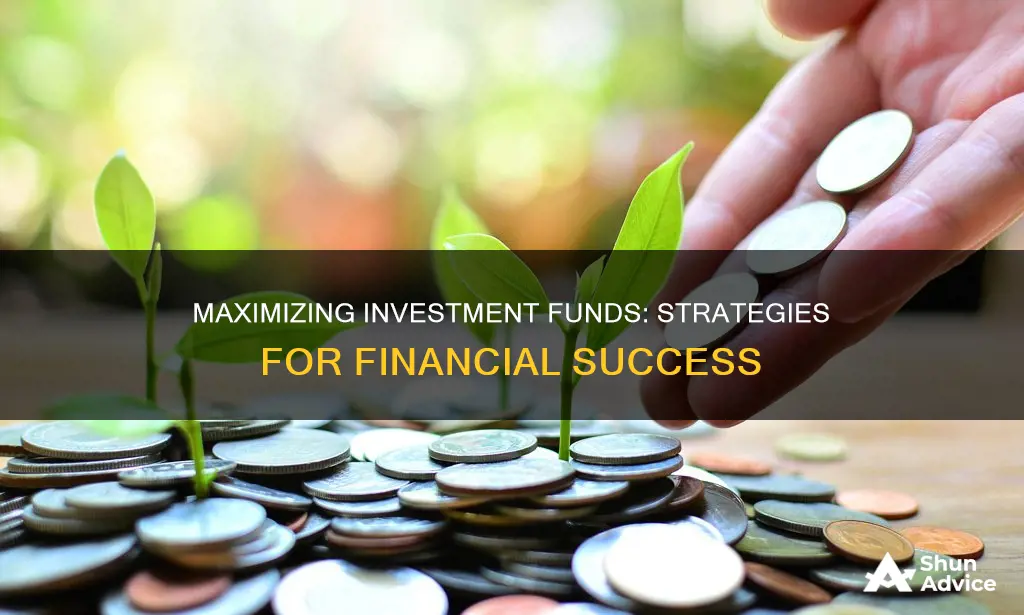
Investing is a great way to make your money work for you. There are several ways to make money with investment funds, and the best option depends on your risk tolerance, budget, and financial goals. Here are some common strategies to make money with investment funds:
1. Diversification: Diversification is a crucial concept in investing, and it involves spreading your investments across various assets, industries, or geographic regions to reduce risk. A common approach is to invest in a mix of stocks and bonds, with stocks offering higher potential returns and bonds providing more stability.
2. Long-Term Investing: Adopting a buy-and-hold strategy and investing for the long term is generally recommended. The stock market has historically provided strong average annual returns, and staying invested through ups and downs increases your chances of capturing those returns.
3. Funds Over Individual Stocks: Investing in funds, such as mutual funds or exchange-traded funds (ETFs), provides instant diversification and is often recommended over picking individual stocks, as it's challenging to consistently select winning stocks. Funds also allow you to invest in a broad range of companies with a smaller amount of money.
4. Reinvesting Dividends: Many companies pay dividends, which are distributions of their profits to shareholders. Reinvesting these dividends compounds your returns over time, helping your investment grow faster.
5. Choosing the Right Investment Account: Selecting the appropriate investment account is crucial. Tax-advantaged accounts, like 401(k)s or Individual Retirement Accounts (IRAs), offer tax benefits but have restrictions on withdrawals. Taxable brokerage accounts provide more flexibility for withdrawals but don't offer the same tax advantages.
6. Robo-Advisors: If you're a beginner or prefer a more hands-off approach, consider using a robo-advisor. These automated services construct and manage investment portfolios based on your risk tolerance and financial goals.
7. Real Estate: Real estate is another popular way to build wealth. You can invest in rental properties or explore alternative options like real estate investment trusts (REITs), which are traded on stock exchanges.
8. Speculative Investments: For those with a high-risk tolerance, speculative investments like options, margin trading, penny stocks, or cryptocurrencies can offer the potential for rapid gains but also carry a higher risk of significant losses.
| Characteristics | Values |
|---|---|
| Investment type | Stocks, bonds, mutual funds, exchange-traded funds (ETFs), certificates of deposit (CDs), savings accounts, real estate, cryptocurrencies, options, margin trading, penny stocks |
| Investment style | Active investing, passive investing |
| Investment budget | $100 minimum |
| Risk tolerance | High, medium, low |
| Investment timeline | Short-term, long-term |
| Investment account | 401(k), Roth IRA, traditional brokerage account, taxable brokerage account, individual retirement account (IRA) |
| Diversification | Yes, to reduce risk and boost returns |
| Reinvestment | Yes, to compound interest |
What You'll Learn

Opt for funds over individual stocks
Investing in mutual funds is often safer and less complicated than investing in individual stocks. Mutual funds pool money from a group of investors and invest in different securities, such as stocks, bonds, or short-term securities. Each fund has a different investment objective, which drives its strategy and selection of investments.
Diversification
Mutual funds offer instant diversification, allowing investors to spread their investments across different holdings to minimize potential losses. This diversification reduces the risk of losing money if one particular stock performs poorly. By investing in a mutual fund, you gain exposure to a multitude of stocks, lowering the risk compared to owning a single stock.
Convenience
Mutual funds offer convenience by allowing investors to defer the decision-making process to an investing expert. Instead of spending time and effort researching individual stocks, investors can rely on the expertise of fund managers, who are responsible for generating income and protecting the portfolio's value.
Lower Costs
Mutual funds also provide the benefit of lower costs. The cost of trading in a mutual fund is spread over all investors in the fund, resulting in a lower cost per individual. This is especially advantageous when compared to the cost of trading individual stocks, where brokerage firms may charge the same commission for one share or 5,000 shares.
Reduced Risk
Investing in individual stocks can be risky, as stock prices can fluctuate significantly. By investing in a mutual fund, you benefit from a diversified portfolio that aims to balance risk and return. While mutual funds do not guarantee profits, they aim to reduce investment risk through diversification.
Professional Management
Mutual funds are managed by professional portfolio managers who select and manage the stocks within the fund. These experts have the knowledge and experience to make informed investment decisions, increasing the likelihood of meeting or beating the performance of a specific benchmark.
In summary, opting for funds over individual stocks can provide investors with the benefits of diversification, convenience, lower costs, reduced risk, and professional management. Mutual funds are a good choice for those who want to invest without the time and effort required to research and select individual stocks.
Global Bond Funds: Diversify and Grow Your Investments
You may want to see also

Reinvest your dividends
Reinvesting your dividends is a great way to build wealth over time. Dividends are a reward, usually in the form of cash, that a company or fund gives to its shareholders on a per-share basis. When a company earns a profit, it can choose to reinvest the cash in its operations, pay down its debt obligations, or pay dividends to shareholders. Dividends are typically paid out quarterly, and the decision to pay them is made when a company finalises its income statement and the board of directors reviews the financials.
When you reinvest your dividends, you are choosing to buy more shares with the dividend instead of taking the cash. This can be done manually or through a dividend reinvestment plan (DRIP). A DRIP is a strategy that automatically reinvests dividends to purchase additional shares of a security. With a DRIP, your cash dividends are reinvested into your account automatically, helping you accumulate more shares of the same stock, at no extra charge. DRIPs can be set up through your brokerage or directly with the companies, typically via third-party-administered programs known as direct stock purchase plans (DSPPs).
There are several benefits to reinvesting your dividends:
- Enhanced returns: Reinvesting your dividends allows you to purchase additional shares of stock with your cash dividend, potentially increasing your total return.
- Wealth accumulation: Over time, reinvesting your dividends can help you build wealth quietly and steadily, providing a stable stream of investment revenue, especially useful for retirement.
- Compounding effect: Reinvesting your dividends puts the power of compounding to work for you. Your dividends buy more shares, which increases your dividend the next time, which, in turn, lets you buy even more shares, and so on.
- Dollar-cost averaging: Reinvesting your dividends consistently means you are buying shares regularly, which averages out the purchase price over time, reducing the impact of market volatility.
- Fractional shares: Through dividend reinvestment, you can often buy fractional shares, which are typically not available when purchasing shares on the open market.
- Cost-effectiveness: Reinvesting your dividends is generally a cheap option as you won't owe any commissions or other brokerage fees when buying more shares.
- Simplicity and flexibility: Setting up a DRIP is straightforward and automatic, and you can choose to stop reinvesting and take the cash at any time.
Despite the benefits, there are also some considerations to keep in mind. Reinvesting your dividends may not always be the right choice, depending on your situation and financial goals. Here are a few scenarios where it may not make sense to reinvest:
- Retirement income: If you are at or near retirement and need the income, you may want to take the dividends as cash instead of reinvesting them.
- Poor performance: If the underlying asset is performing poorly or the stock price is stagnant or consistently going down, you may want to pocket the dividends or consider selling the shares.
- Diversification: Taking the dividends in cash allows you to diversify your investments by allocating that money to other assets or investment opportunities.
- Portfolio balance: Reinvesting dividends in a high-yielding, fast-growing security can overweight your portfolio in a few investments. If these securities perform well, it's great, but if they don't, the losses will be more significant.
In conclusion, reinvesting your dividends can be a powerful tool for building wealth and enhancing your investment returns. However, it's important to consider your financial situation, risk tolerance, and investment goals when deciding whether to reinvest or take the cash. Consult with a financial advisor or tax professional to determine the best course of action for your specific circumstances.
Retirement Fund Investment: Where to Place Your Money Wisely
You may want to see also

Choose the right investment account
Choosing the right investment account is a crucial step in your investment journey. Here are some factors to consider when selecting the most suitable investment account:
Types of Investment Accounts
Investment accounts can be broadly categorized into two types: registered accounts and non-registered accounts.
- Registered Accounts: These accounts offer government benefits such as tax sheltering, income tax deductions, or tax-free capital gains. Examples include Registered Retirement Savings Plans (RRSPs), Tax-Free Savings Accounts (TFSAs), and First Home Savings Accounts (FHSAs). RRSPs are popular for retirement savings, with tax-deductible contributions and tax-sheltered earnings. TFSAs also offer tax advantages, allowing tax-free withdrawals anytime. FHSAs are designed for first-time homebuyers, providing tax advantages similar to RRSPs and TFSAs.
- Non-Registered Accounts: These accounts do not offer tax benefits but typically have no limits on deposits. Margin accounts, for instance, allow you to borrow funds from the brokerage to invest, offering benefits like no contribution limits and leverage but also carry risks, including capital gains tax and interest charges. Cash accounts, on the other hand, provide a simpler, more flexible, and predictable option without the ability to borrow money.
Setting Clear Financial Goals
Before choosing an investment account, it's essential to establish clear financial goals. Consider factors such as your assets, debts, income, and expenses. Define specific, measurable, agreed-upon, realistic, and time-bound (SMART) goals to help guide your investment decisions effectively.
Investment Risk and Return
Understanding your risk tolerance is vital when selecting an investment account. Assess how much financial risk you are willing to take. While some investments, like high-quality bonds, offer predictable returns with low risk, others, such as stocks, carry higher risk but also offer higher potential returns. Diversification can help balance risk and return by spreading your investments across various assets.
Investment Knowledge and Time Commitment
Consider the time and knowledge you are willing to dedicate to investing. Active investing requires extensive research, analysis, and ongoing monitoring of your investments. In contrast, passive investing involves using investment vehicles where professionals handle the hard work, such as mutual funds or robo-advisors.
Account Features and Requirements
Different investment accounts have varying features and requirements. For example, some accounts have minimum contribution limits or age restrictions. Others may offer employer-matching contributions or tax advantages. Ensure you understand the specifics of each account type before deciding.
Seeking Professional Advice
If you're unsure about choosing the right investment account, consider seeking advice from a qualified financial advisor or a specialist. They can provide personalized recommendations based on your financial goals, risk tolerance, and investment horizon.
Money Market Funds: Where Are Your Investments Going?
You may want to see also

Explore new industries
Exploring new industries is a great way to make money with investment funds. Here are some tips to help you get started:
Diversify your portfolio
Diversification is a crucial strategy when investing in new industries. By spreading your investments across various sectors, you can reduce the risk associated with putting all your eggs in one basket. This strategy is often referred to as "not putting all your eggs in one basket." It is essential to remember that even well-established companies can be hit by crises, so diversifying your portfolio can help mitigate the impact of any single company's performance.
Do your research
When exploring new industries, it is crucial to conduct thorough research. This includes understanding the industry's dynamics, the competitive landscape, and the companies' financial health and growth prospects. Look for companies with a solid history of dividend increases rather than those with the highest current yield, as this could be a sign of impending trouble. Additionally, consider the industry's long-term growth potential and whether it aligns with your investment goals.
Consider growth industries
When exploring new industries, look for sectors with strong growth potential. For example, technology and healthcare are often considered growth industries due to their innovative nature and ability to disrupt existing markets. These industries tend to be more volatile but can offer significant returns over the long term.
Stay up-to-date with market trends
Keep yourself informed about market trends and developments in the industries you are exploring. This will help you make more informed investment decisions and allow you to react quickly to any changes in the market. Subscribe to industry publications, follow thought leaders, and utilise online resources to stay ahead of the curve.
Monitor your investments regularly
Regularly review and adjust your investments as necessary. The performance of companies and industries can fluctuate over time due to various factors, such as economic conditions, regulatory changes, and competition. By staying proactive and monitoring your investments, you can take advantage of emerging opportunities or mitigate potential losses by making timely adjustments.
Consider seeking expert advice
If you are new to investing or exploring a particularly complex industry, consider seeking advice from financial advisors or brokers. They can provide personalised guidance based on your financial goals, risk tolerance, and the specific industry you are interested in. Their expertise can help you navigate potential pitfalls and make more informed investment decisions.
Mutual Funds: When to Hold Back on Investments
You may want to see also

Explore passive investing
Passive investing is a long-term investment strategy that focuses on buying and holding a diverse range of investments over a long period. The goal is to build wealth gradually and rely on the market to provide positive returns over time.
Passive investing is typically done by investing in a mutual fund or exchange-traded fund (ETF) that mimics the holdings of a particular market index, such as the S&P 500. This strategy aims to cut the costs of deciding which securities to invest in by reducing the fees triggered by frequent trading. It also simplifies the portfolio construction process.
Index investing is the most common form of passive investing. With this approach, investors seek to replicate and hold a broad market index. Passive investing is less expensive and complex than active management and often produces superior after-tax results over medium to long time horizons.
Benefits
- Lower maintenance: Passive investing does not require constant tracking of investment performance, as it is a long-term strategy.
- Steady returns: Passive funds have historically outperformed active funds in the long term.
- Lower fees: Passive investing involves less frequent buying and selling, resulting in lower expense ratios.
- Lower capital gains taxes: Holding assets for the long term means paying less in capital gains taxes.
- Lower risk: Passive investing reduces risk by diversifying across a broad mix of asset classes and industries.
Drawbacks
- Limited investment options: Investors cannot handpick individual investments in an index fund or ETF.
- May not get above-market returns: Passive investing aims to match the market average, so above-market returns may not be achievable.
- Lack of flexibility: Passive fund managers are usually prohibited from using defensive measures, such as reducing their position in shares of particular securities.
Passive investing strategies include buying index funds or ETFs, which are types of mutual funds. Robo-advisors, which use computer algorithms to choose investments, are another option for passive investors. Additionally, it is possible to actively manage a passive portfolio through diversification and direct indexing.
Fidelity's Energy Sector Fund: A Smart Investment Choice?
You may want to see also
Frequently asked questions
The best way to make money with investment funds is to adopt a buy-and-hold strategy, where you hold stocks or other securities for a long time instead of engaging in frequent buying and selling.
You can get started by opening an investment account, such as a 401(k), Roth IRA, or traditional brokerage account.
Investing in funds provides more diversification and less risk than investing in individual stocks. Funds also require less time, knowledge, and money to get started.
You should consider your risk tolerance and financial goals when choosing a fund to invest in. It's important to do your research and understand the fees and investment choices available.
One common mistake to avoid is trying to time the market. It's impossible to predict the best days to be invested in the market, and you may miss out on opportunities for strong returns. Instead, focus on staying invested for the long term.







